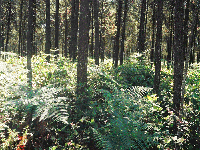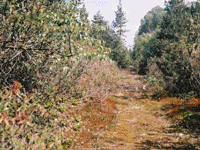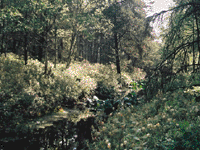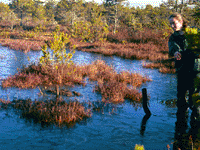| Pine-Sphagnum community
|
||
Lodgepole pine (shore pine) - Sphagnum - Shrubs (Heathland) |
||
|
Also called heathland, the Pine-Sphagnum region is most representative of Burns Bog. Before the large scale human disturbances that occurred during the last century, this community would have dominated most of the Bog. Because of the overwhelming dominance of lodgepole pines (Also known as shore pine), Burns Bog is classified as a "Pine bog", as opposed to "Spruce bogs", which occur mainly in northern regions. In a typical Pine-Sphagnum community, pine grows to less than 2 meters in height because of the Bog's extreme conditions. As a result, there is no tree canopy to block sunlight. However, plants still grow very slowly here. Sphagnum grows only 2 mm a year, and pine trees that are 100 years old may only be up to waist's height. The lack of a tree canopy distinguishes the region from the Pine-salal community. |
|

|
| Back to Top | ||
|
This picture is taken at the northern edge of the Bog. Pine and ferns dominate the landscape. Bracken ferns are considered invasive in bogs. They grow very quickly and take over the space previously occupied by Sphagnum. It is not always easy to distinguish between Pine-salal and Pine-Sphagnum communities. |
|

|
| Back to Top | ||
|
This picture is taken in an old peat harvesting site. Some plant species native to bogs, such as lodgepole pine and Labrador tea have re-colonized the area since peat harvesting stopped in 1984. Burns Bog has seen a variety of peat harvesting methods. On the eastern sector of the Bog (where this photo is taken), ditches were built to facilitate the extraction. In this area, unfortunately, peat mosses (Sphagnum species) have not returned because of the drainage by nearby ditches. On this picture, mosses are present, but they are not Sphagnum (bog) mosses. Scientists found that Sphagnum cover in the northeast sector of the Bog, where this picture was taken, was less than 5%. |
|

|
| Back to Top | ||
|
This is a typical ditch in the southeast sector of Burns Bog. Sphagnum is present but is hidden under the Salal. In general, Sphagnum cover is low in the southeast of Burns Bog. Yellow pond lilies are present in many ditches in Burns Bog. Paper birch trees are also frequent along ditches. Several meters away from this location, lodgepole pine will dominate. That is the reason why this area is classified as "Pine-Sphagnum-Shrubs". |
|

|
| Back to Top | ||
|
The ponds you see on this picture may be formed as a result of human use. All along the trail, visitors have trampled on the vegetation along the trail. After the vegetation was destroyed, the soft soil could no longer hold the weight of people. The trail gradually became depressed and filled with water. These ponds illustrate that a Sphagnum bog, especially the Pine-Sphagnum region, is extremely sensitive to environmental changes. The slightest alteration can put this ecosystem at risk. Smaller bogs are more susceptible to environmental changes than bigger ones. Because all the bogs on the protected list are small bogs, none of the parks and nature reserves in our region is completely successful in protecting the Pine-Sphagnum regions of bogs. In other protected ones, invasion by non-bog species, lowering of the water table, introduction of nutrients have unfortunately eliminated this landscape. |
|

|